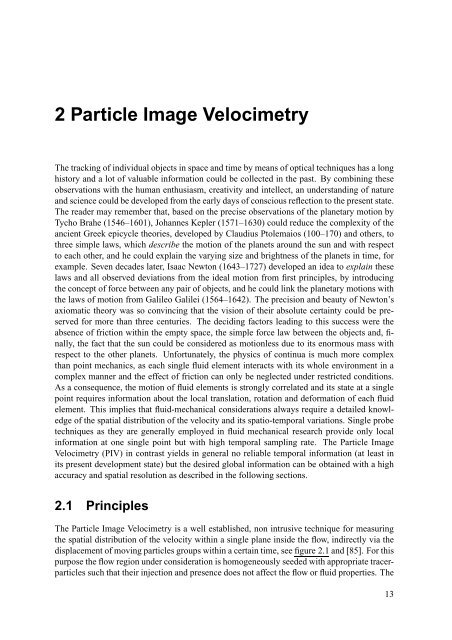The significance of coherent flow structures for the turbulent mixing ...
The significance of coherent flow structures for the turbulent mixing ...
The significance of coherent flow structures for the turbulent mixing ...
You also want an ePaper? Increase the reach of your titles
YUMPU automatically turns print PDFs into web optimized ePapers that Google loves.
2 Particle Image Velocimetry<br />
<strong>The</strong> tracking <strong>of</strong> individual objects in space and time by means <strong>of</strong> optical techniques has a long<br />
history and a lot <strong>of</strong> valuable in<strong>for</strong>mation could be collected in <strong>the</strong> past. By combining <strong>the</strong>se<br />
observations with <strong>the</strong> human enthusiasm, creativity and intellect, an understanding <strong>of</strong> nature<br />
and science could be developed from <strong>the</strong> early days <strong>of</strong> conscious reflection to <strong>the</strong> present state.<br />
<strong>The</strong> reader may remember that, based on <strong>the</strong> precise observations <strong>of</strong> <strong>the</strong> planetary motion by<br />
Tycho Brahe (1546–1601), Johannes Kepler (1571–1630) could reduce <strong>the</strong> complexity <strong>of</strong> <strong>the</strong><br />
ancient Greek epicycle <strong>the</strong>ories, developed by Claudius Ptolemaios (100–170) and o<strong>the</strong>rs, to<br />
three simple laws, which describe <strong>the</strong> motion <strong>of</strong> <strong>the</strong> planets around <strong>the</strong> sun and with respect<br />
to each o<strong>the</strong>r, and he could explain <strong>the</strong> varying size and brightness <strong>of</strong> <strong>the</strong> planets in time, <strong>for</strong><br />
example. Seven decades later, Isaac Newton (1643–1727) developed an idea to explain <strong>the</strong>se<br />
laws and all observed deviations from <strong>the</strong> ideal motion from first principles, by introducing<br />
<strong>the</strong> concept <strong>of</strong> <strong>for</strong>ce between any pair <strong>of</strong> objects, and he could link <strong>the</strong> planetary motions with<br />
<strong>the</strong> laws <strong>of</strong> motion from Galileo Galilei (1564–1642). <strong>The</strong> precision and beauty <strong>of</strong> Newton’s<br />
axiomatic <strong>the</strong>ory was so convincing that <strong>the</strong> vision <strong>of</strong> <strong>the</strong>ir absolute certainty could be preserved<br />
<strong>for</strong> more than three centuries. <strong>The</strong> deciding factors leading to this success were <strong>the</strong><br />
absence <strong>of</strong> friction within <strong>the</strong> empty space, <strong>the</strong> simple <strong>for</strong>ce law between <strong>the</strong> objects and, finally,<br />
<strong>the</strong> fact that <strong>the</strong> sun could be considered as motionless due to its enormous mass with<br />
respect to <strong>the</strong> o<strong>the</strong>r planets. Un<strong>for</strong>tunately, <strong>the</strong> physics <strong>of</strong> continua is much more complex<br />
than point mechanics, as each single fluid element interacts with its whole environment in a<br />
complex manner and <strong>the</strong> effect <strong>of</strong> friction can only be neglected under restricted conditions.<br />
As a consequence, <strong>the</strong> motion <strong>of</strong> fluid elements is strongly correlated and its state at a single<br />
point requires in<strong>for</strong>mation about <strong>the</strong> local translation, rotation and de<strong>for</strong>mation <strong>of</strong> each fluid<br />
element. This implies that fluid-mechanical considerations always require a detailed knowledge<br />
<strong>of</strong> <strong>the</strong> spatial distribution <strong>of</strong> <strong>the</strong> velocity and its spatio-temporal variations. Single probe<br />
techniques as <strong>the</strong>y are generally employed in fluid mechanical research provide only local<br />
in<strong>for</strong>mation at one single point but with high temporal sampling rate. <strong>The</strong> Particle Image<br />
Velocimetry (PIV) in contrast yields in general no reliable temporal in<strong>for</strong>mation (at least in<br />
its present development state) but <strong>the</strong> desired global in<strong>for</strong>mation can be obtained with a high<br />
accuracy and spatial resolution as described in <strong>the</strong> following sections.<br />
2.1 Principles<br />
<strong>The</strong> Particle Image Velocimetry is a well established, non intrusive technique <strong>for</strong> measuring<br />
<strong>the</strong> spatial distribution <strong>of</strong> <strong>the</strong> velocity within a single plane inside <strong>the</strong> <strong>flow</strong>, indirectly via <strong>the</strong><br />
displacement <strong>of</strong> moving particles groups within a certain time, see figure 2.1 and [85]. For this<br />
purpose <strong>the</strong> <strong>flow</strong> region under consideration is homogeneously seeded with appropriate tracerparticles<br />
such that <strong>the</strong>ir injection and presence does not affect <strong>the</strong> <strong>flow</strong> or fluid properties. <strong>The</strong><br />
13
















